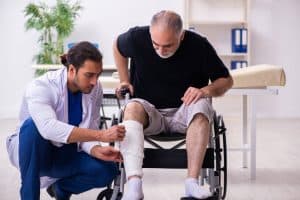Why Do My Shins Hurt When I Run
Shin bone pain is quite common during running, whether you’re a beginner who has been running for a few months or a seasoned runner who is competing at the highest levels. Since it’s quite a common running injury, a lot of runners end up asking “why do my shins hurt when I run?”
While stress fracture is still a possibility, the majority of cases where shins hurt while running are caused by shin splints. This is a minor condition known as “medial tibial stress syndrome” that causes pain accompanied by slight swelling around the shins due to overuse of muscles, connective tissues, and tendons.
In today’s article, we’ll walk you through a brief guide with everything you need to know about shin pain, and what you should do about it. Let’s dive right in!
Why Do My Shins Hurt When I Run?
Between the knee and the ankle, there are two bones in the human body, which are known as the tibia and the fibula. However, when we say shinbone, we usually refer to the larger and thicker one that handles the majority of support of that area, which is the tibia.
Tibias are usually under noticeable stress while running, as they need to handle the weight of almost all of your body. For that reason, they’re prone to some overuse injuries that can cause shin pain.
The most common of all these injuries is shin splints and tibial stress fractures, although the latter is less likely and is usually considered a complication of the first.
Other conditions can also cause shin pain, such as injuries and inflammation in tendons and muscles around the shin bone, but they’re all significantly less common than shin splints.
What Exactly Are Shin Splints?
If you want to know how to deal with shin splints, you should know more about the condition. In this section, we’ll take a quick look at this condition and what causes it.
A shin splint is usually a term that describes any minor overuse injury that affects the lower leg bones. The medical name of shin splints is “medial tibial stress syndrome (MTSS)”.
The pain is typically caused by small tears and damage to the tissue of the shin bone or the muscles that surround it (posterior tibialis or anterior tibialis muscle).
The site of the pain will usually depend on the affected part of the shin, although it’s usually classified as lower leg pain. For example, shin splints that affect the front of the shit are called “anterior shin splints” while the ones at the back are called “posterior shin splints”.
Are Shin Splints Common Among Runners?

Shin splints are surprisingly common, especially among beginners who already have weaker or untrained leg muscles.
In fact, according to a study on the condition, it affects anywhere between 5% to 35% of all runners. The study also shows that they can affect a huge range of people, such as:
- Military personnel, dancers, and those who spend a lot of time walking or standing
- Runners with flat feet
- Patients with bone density problems, such as osteopenia and osteoporosis
- Anyone who runs without a proper supportive shoe for running
What Causes Shin Splints?
Now that you know more about shin splints and how common they are, you might be wondering about the situations that cause them. In this section, we’ll walk you through all these causes, so you can avoid them in the future:
1. Overtraining
Since shin splints are overuse injuries, excessive training is one of the main reasons why people get them.
Hard exercise like running for long distances without rest days is one of the main causes of the condition.
2. Ramping Up Your Running Routine Suddenly
If you’re new to doing any sort of physical activity, you need to take things slowly in order to avoid injuries like shin splints.
If you suddenly increase your mileage or training days, your shin will easily develop these stress injuries.
3. Hard Impacts
Whether it’s hitting your shin bone or running on rough surfaces, sudden shocks can take a huge toll on your shin bone and cause shin splints
4. Improper Technique
Although our bodies are built to run for a long distance, a lot of beginners don’t maintain a proper posture while running, especially if they have flat feet. In that case, shin splints become a serious risk as well as serious complications like stress fractures.
5. Weak Lower Leg Muscles
Your calf muscle and tendon are responsible for absorbing some of the shocks on the tibia while running. If you have weaker leg muscles, your chances of getting a shin bone injury start to increase.
Are Shin Splints Treatable?
Although shin splints pain is quite frustrating and makes it extremely difficult to run properly, the good news is that it’s not a permanent case.
Not only that, but it’s usually curable and even goes away on its own in most situations. The duration of the condition will vary depending on various aspects, such as:
- The intensity of the first impact that caused the injury
- Whether you’re going to train with the injury or take the time off
- Whether you’re suffering from underlying conditions, such as bone problems
- Your recovery rate, which is usually genetic
- Whether you’re going to follow a recovery plan and stick to the treatment
As you can notice, there are plenty of factors that can affect the time needed to heal from a shin splint, but since it’s generally a minor injury at best, it usually takes anywhere between 3 to 5 weeks for the tissue to fully heal.
You can also speed up your recovery rate by following the best course of treatment for such a condition, which is known as the R.I.C.E Protocol. This treatment includes:
- Resting or reducing the impact of your exercise to a minimum
- Icing your knees with cold packs
- Applying compression on your shins using bandages or tape
- Elevating the legs whenever possible
In addition to the R.I.C.E Protocol, you can also take some over the counter pain medications to help in alleviating the pain. Non-steroidal anti-inflammatory drugs (NSAIDs) like ibuprofen are usually ideal because they also help in managing inflammation.
Your doctor may also prescribe corticosteroid injections that can speed up the recovery rate significantly.
Can I Run With Shin Splints?

Shin splints are generally classified as a minor condition, so you can still run while suffering from one. However, just because you can, doesn’t mean that you should.
As you already know, a shin splint is an overuse injury that happens either due to running on extensively hard surfaces or because of overloading your shin muscles and tendons.
Training on an injury is rarely a good idea because it can cause a lot of unnecessary and completely avoidable problems.
For starters, rest is a major aspect of the R.I.C.E protocol. Training on an injury will only make it last longer because the connective tissues and inflammations don’t get enough time to heal.
This doesn’t only affect your performance for a longer time, but can also worsen the case and cause serious complications of shin splints, such as tibial stress fractures.
Even when you’re careful, when you’re injured, your form and posture are usually at a compromise. This can actually do more damage than good by causing other injuries, such as knee or ankle injuries.
If you must run on a shin splint injury, make sure that you always use bandages and tape to prevent further injuries, run on relatively soft surfaces, wear shock absorbing shoes, and tune down your mileage to the minimum acceptable range.
How to Prevent Shin Splints While Running
While shin splints are minor, they can be quite painful while running. Unfortunately, those who already suffered from the condition are usually at high risk of suffering from shin splints again. In this section, we’ll guide you through the best practices to help you avoid this painful condition:
Always Work Your Way Up Gradually
If you want to increase the intensity of your exercise, you don’t have to do it suddenly. Instead, take your time and spread your ramp-up plans on a larger schedule so that your body is capable of tolerating and adapting to these changes.
Avoid Shin Splint Factors
As previously mentioned, running up or downhill as well as across uneven terrain are major factors that cause shin splints. Instead, always run on proper running tracks that have a layer of shock absorbing foam to reduce the impact on your shins.
Workout to Increase Your Muscle Strength
Lower leg muscles don’t only increase your endurance, but they also double as a shock absorbing mechanism. Strengthening the muscles reduces the impact of runs on the shins.
Wear a Supportive Running Shoe
Lastly, if you suffer from flat feet or other conditions that affect your support or posture, it’s always recommended that you opt for a proper running shoe while working out. These shoes have a lot of cushions that keep you comfortable and absorb hard shocks.
When to Seek Medical Help Regarding Shin Splints?

Since shin splints are common and are considered a relatively minor condition, a lot of runners don’t need to visit a doctor regarding the pain.
Of course, visiting your doctor is always a good idea, especially if you run at a competitive level to maximize your recovery speed. However, if you run casually, you only need to see a doctor regarding shin splints in the following situations:
- The pain is extremely intolerable
- Your shins are swelling badly and the pain continues for a long time even with R.I.C.E protocol and other treatments. (the shins are getting warmer and noticeably red)
- The pain is extended beyond your shins and across your feet, knees, or ankles
- You already suffer from underlying and chronic conditions that can worsen the shin splint pain and make it harder to go away on its own, such as flat foot or compartment syndrome.
In addition to regular treatments that will help in alleviating the pain, doctors can also prescribe various treatments that can help in reducing the swelling quickly, such as corticosteroid injections.
Additionally, they may recommend visiting a physical therapist to also speed up the recovery and rehabilitation time.
Final Thoughts On Why Do My Shins Hurt When I Run
With that said, you now have a brief guide that answers the popular question “why do my shins hurt when I run?”
As you can see, there are several reasons why your shins might hurt, whether it’s only while running or throughout the day.
The most common condition that causes pain in that area is shin splints, and luckily, shin splints will usually go away on their own within a few weeks, especially if you tune down the stress on your shins and follow the R.I.C.E protocol to help the tendons and muscles around the shin to heal as well.

